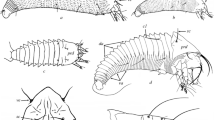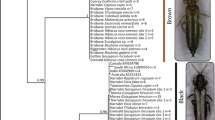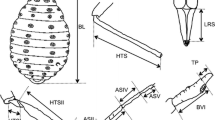Abstract
Allozymes and morphological characters were used to test whether host race evolution—the genetic divergence of parasitic populations caused by adaptation to different host species—has occurred in desert mistletoe,Phoradendron californicum. Populations ofPhoradendron californicum from two hosts,Acacia greggii andProsopis glandulosa, were surveyed from the Mojave and Colorado deserts. Electrophoretic data indicated genetic differentiation of mistletoes occurring on these hosts. Three of four morphological characters (internode length, main shoot lateral shoot diameter ratio and berry color) also showed significant host-specific differentiation. These data support the hypothesis that host race formation has occurred or is occurring in this parasitic angiosperm.
Similar content being viewed by others
References
Bush, G. L., 1974: The mechanism of sympatric host race formation in true fruit flies (Tephritidae). — InWhite, M. J. D., (Ed.): Genetic mechanisms of speciation in insects, pp. 3–23. — Sydney: Australian & New Zealand Book Co.
—, 1975: Modes of animal speciation. — Ann. Rev. Ecol. Syst.6: 339–364.
Clay, K., Dement, D., Rejmanek, M., 1985: Experimental evidence for host races in mistletoe (Phoradendron tomentosum). — Amer. J. Bot.72: 1225–1231.
Cowels, R. B., 1972: Mesquite and mistletoe. — Pacific Discovery23: 19–24.
Ehleringer, J. R., Schulze, E.-D., Ziegler, H., Lange, O. L., Farquhar, G. D., Cowar, I. R., 1985: Xylem-tapping mistletoes: water or nutrient parasites? — Science227: 1479–1481.
Gottlieb, L. D., 1981: Electrophoretic evidence and plant populations. — Prog. Phytochem.7: 1–46.
Grant, V., 1981: Plant speciation. — New York: Columbia University Press.
Hemmerly, T. E., Forsythe, A. A., Womack, M. L., 1979: Blackgum—exclusive host of mistletoe in Lawerence Co., Tennessee. — J. Tenn. Acad. Sci.54: 89–90.
James, R. L., 1958: Mistletoes in Tennessee. — Castanea23: 91–95.
Jermy, T., 1984: Evolution of insect/host plant relationships. — Amer. Naturalist124: 609–630.
Kuijt, J., 1969: The biology of parasitic flowering plants. — Berkeley: University of California Press.
Levin, D. A., 1978: The origin of isolating mechanisms in flowering plants. — Evol. Biol.11: 185–317.
May, D. S., 1971: The role of populational differentiation in experimental infection ofProsopis byPhoradendron. — Amer. J. Bot.58: 921–931.
Munz, P. A., Keck, D. D., 1959: A California flora. — Berkeley: University of California Press.
Nei, M., 1973: The theory and estimation of genetic distance. — InMorton, N. E., (Ed.): Genetic structure of populations, pp. 45–54. — Honolulu: University of Hawaii Press.
Nilsen, E. T., Sharifi, M. R., Rundel, P. W., 1984: Comparative water relations of phreatophytes in the Sonoran desert of California. — Ecology65: 767–788.
Pietrewicz, T. A., Kamil, A. C., 1981: Search images and the detection of cryptic prey: an operant approach. — InKamil, A. C., Sargent, T. D., (Eds.): Foraging behavior, ecological ethological and phycological approaches. — New York: Garland STPM Press.
Reed, C. F., Reed, P. G., 1951: Host distribution of mistletoe in Kentucky. — Castanea16: 7–15.
Schneck, J., 1884: Notes onPhoradendron flavescens, NVH. II. — Bot. Gaz.9: 101–103.
Singer, O., 1958: Ein Beitrag zur Kenntnis der Mistel (Viscum album L.). — Pharmazie13: 781–783.
Spooner, D. M., 1983: The northern range of eastern mistletoes,Phoradendron serotinum (Viscaceae), and its status in Ohio. — Bull. Torrey Bot. Club110: 489–493.
Statler, R., 1971: Arborescent preference ofPhoradendron flavescens. — Castanea41: 31–33.
Thompson, V. E., Mahall, B. E., 1983: Host specificity by a mistletoe,Phoradendron villosum (Nutt.)Nutt. subsp.villosum, on three oak species in California. — Bot. Gaz.144: 124–133.
Tubeuf, von, 1923: Monographie der Mistel. — Munich, Berlin: R. Oldenbourg, 832 pp.
Walsberg, G. E., 1975: Digestive adaptations ofPhainopepla nitens associated with the eating of mistletoe berries. — Condor77: 167–174.
Wendel, J. F., Stuber, L. W., 1984: Plant isozymes: Enzymes studied and buffer systems for their electrophoretic resolution in starch gels. — Isozyme Bull.17: 4–11.
Author information
Authors and Affiliations
Rights and permissions
About this article
Cite this article
Glazner, J.T., Devlin, B. & Ellstrand, N.C. Biochemical and morphological evidence for host race evolution in desert mistletoe,Phoradendron californicum (Viscaceae). Pl Syst Evol 161, 13–21 (1988). https://doi.org/10.1007/BF00936008
Received:
Issue Date:
DOI: https://doi.org/10.1007/BF00936008




